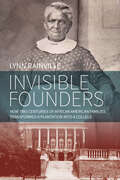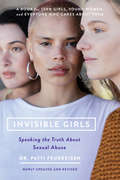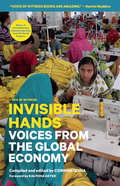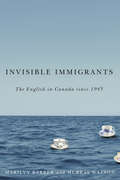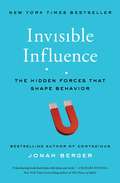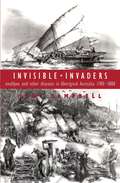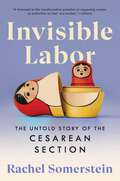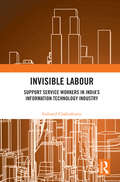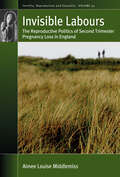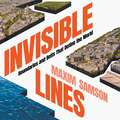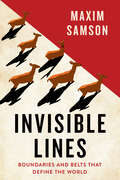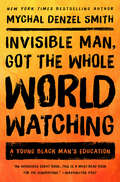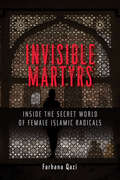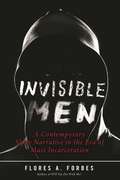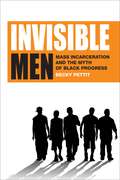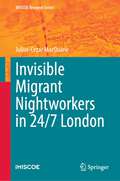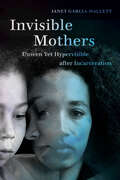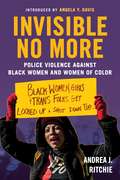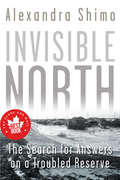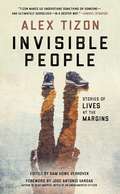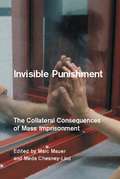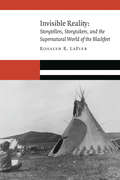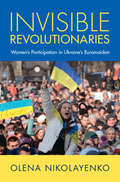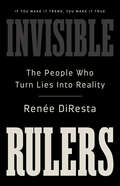- Table View
- List View
Invisible Founders: How Two Centuries of African American Families Transformed a Plantation into a College
by Lynn RainvilleLiteral and metaphorical excavations at Sweet Briar College reveal how African American labor enabled the transformation of Sweet Briar Plantation into a private women’s college in 1906. This volume tells the story of the invisible founders of a college founded by and for white women. Despite being built and maintained by African American families, the college did not integrate its student body for sixty years after it opened. In the process, Invisible Founders challenges our ideas of what a college “founder” is, restoring African American narratives to their deserved and central place in the story of a single institution — one that serves as a microcosm of the American South.
Invisible Girls: The Truth About Sexual Abuse
by Patti FeuereisenA powerful source of healing for teen girls and young women who have experienced sexual abuse, Invisible Girls offers survivors agency and hope in an era when too many girls have suffered aloneThe statistics are staggering. One in four girls will experience sexual abuse by the time she is sixteen, and 48 percent of all rapes involve a young woman under the age of eighteen. It's not surprising then, that in a society where sexual abuse of young women is rampant, many women never share their stories. They remain hidden and invisible. In her pioneering work with young survivors through the last thirty years, Dr. Patti Feuereisen has helped teen girls and young women to find their voices, begin healing, and become visible. In this revised second edition, Dr. Patti's gentle guidance and the girls' powerful stories continue to create an encouraging message: Remarkable healing is possible if girls learn to share their stories in their teens and early twenties. With a new introduction, new chapters, and updated resources, this new edition of Invisible Girls has even more to offer girls, young women, and those who care about them.
Invisible Hands
by Corinne GoriaThe men and women in Invisible Hands reveal the human rights abuses occurring behind the scenes of the global economy. These narrators - including phone manufacturers in China, copper miners in Zambia, garment workers in Bangladesh, and farmers around the world - reveal the secret history of the things we buy, including lives and communities devastated by low wages, environmental degradation, and political repression. Sweeping in scope and rich in detail, these stories capture the interconnectivity of all people struggling to support themselves and their families. Narrators include Kalpona, a leading Bangladeshi labor organizer who led her first strike at 15; Han, who, as a teenager, began assembling circuit boards for an international electronics company based in Seoul; Albert, a copper miner in Zambia who, during a wage protest, was shot by representatives of the Chinese-owned mining company that he worked for; and Sanjay, who grew up in the shadow of the Bhopal chemical disaster, one of the worst industrial accidents in history.
Invisible Immigrants: The English in Canada since 1945
by Marilyn Barber Murray WatsonDespite being one of the largest immigrant groups contributing to the development of modern Canada, the story of the English has been all but untold. In Invisible Immigrants, Barber and Watson document the experiences of English-born immigrants who chose to come to Canada during England’s last major wave of emigration between the 1940s and the 1970s. Engaging life story oral histories reveal the aspirations, adventures, occasional naïveté, and challenges of these hidden immigrants. Postwar English immigrants believed they were moving to a familiar British country. Instead, like other immigrants, they found they had to deal with separation from home and family while adapting to a new country, a new landscape, and a new culture. Although English immigrants did not appear visibly different from their new neighbours, as soon as they spoke, they were immediately identified as “foreign.” Barber and Watson reveal the personal nature of the migration experience and how socio-economic structures, gender expectations, and marital status shaped possibilities and responses. In postwar North America dramatic changes in both technology and the formation of national identities influenced their new lives and helped shape their memories. Their stories contribute to our understanding of postwar immigration and fill a significant gap in the history of English migration to Canada.
Invisible Influence: The Hidden Forces that Shape Behavior
by Jonah BergerThe New York Times bestselling author of Contagious explores the subtle, secret influences that affect the decisions we make--from what we buy, to the careers we choose, to what we eat--in this fascinating and groundbreaking work.If you're like most people, you think that your choices and behaviors are driven by your individual, personal tastes, and opinions. You wear a certain jacket because you liked the way it looked. You picked a particular career because you found it interesting. The notion that our choices are driven by our own personal thoughts and opinions is patently obvious. Right? Wrong. Without our realizing it, other people's behavior has a huge influence on everything we do at every moment of our lives, from the mundane to the momentous occasion. Even strangers have a startling impact on our judgments and decisions: our attitudes toward a welfare policy shift if we're told it is supported by Democrats versus Republicans (even though the policy is the same in both cases). But social influence doesn't just lead us to do the same things as others. In some cases we conform, or imitate others around us. But in other cases we diverge, or avoid particular choices or behaviors because other people are doing them. We stop listening to a band because they go mainstream. We skip buying the minivan because we don't want to look like a soccer mom. In his surprising and compelling Invisible Influence, Jonah Berger integrates research and thinking from business, psychology, and social science to focus on the subtle, invisible influences behind our choices as individuals. By understanding how social influence works, we can decide when to resist and when to embrace it--and how we can use this knowledge to make better-informed decisions and exercise more control over our own behavior.
Invisible Invaders: Smallpox and other diseases in Aboriginal Australia 1780-1880
by Judy CampbellAn epidemic of smallpox among Aboriginal people around the infant colony of Sydney in 1789 puzzled the British, for there had been no cases on the ships of the First Fleet. Where, then, did the epidemic come from? As explorers moved further inland, they witnessed other epidemics of smallpox, notably in the late 1820s and early 1830s and again in the 1860s and 1870s. They also encountered many pockmarked survivors of early epidemics. In Invisible Invaders, Judy Campbell argues that epidemics of smallpox among Australian Aboriginals preceded European settlement. She believes they originated in regular visits to the northern coast of Australia by Macassan fishermen from southern Sulawesi and nearby islands. They were searching for trepang, for which there was a profitable market in China. The Macassan fishermen usually visited during the monsoon season, and the local Indigenous people traded with them. Once the monsoon was over, these Aboriginals resumed their travels into the interior for food, social contact and ritual events, carrying small pox with them. Smallpox thus slowly moved across the continent, eventually reaching the south-east, where it was first recorded by Europeans. Judith Campbell's research on the incidence of smallpox and other diseases among Aboriginal people has extended over more than twenty years. Accumulating evidence from other disciplines supports her findings.
Invisible Labor: The Untold Story of the Cesarean Section
by Rachel SomersteinAn incisive yet personal look at the science and history of the most common surgery performed in America—the cesarean section—and an exposé on the disturbing state of maternal medical careWhen Rachel Somerstein had an unplanned C-section with her first child, the experience was anything but “routine.” A series of errors by her clinicians led to a real-life nightmare: surgery without anesthesia. The ensuing mental and physical complications left her traumatized and searching for answers about how things could have gone so wrong.In the United States, one in three babies is born via C-section, a rate that has grown exponentially over the past fifty years. And while in most cases the procedure is safe, it is not without significant, sometimes life-changing consequences, many of which affect people of color disproportionately. With C-sections all but invisible in popular culture and pregnancy guides, new mothers are often left to navigate these obstacles on their own.Somerstein weaves personal narrative and investigative journalism with medical, social, and cultural history to reveal the operation’s surprising evolution, from its early practice on enslaved women to its excessive promotion by modern medical practitioners. She uncovers the current-day failures of the medical system, showing how pregnant women's agency is regularly disregarded by providers who, motivated by fear of litigation or a hospital’s commitment to efficiency, make far-reaching and deeply personal decisions on behalf of their patients. She also examines what prevailing maternal and medical attitudes toward C-sections tell us about American culture.Invisible Labor lifts the veil on C-sections so that people can make choices about pregnancy and surgical birth with greater knowledge of the risks, benefits, and alternatives, with information on topics including:VBAC (vaginal birth after cesarean) and repeat c-sectionPain and pain management during childbirthHow C-sections can affect family planningThe valuable role of midwives and doulas in the birth experienceThe myths behind “natural” childbirth How limitations put on reproductive rights impact pregnant peopleWith deep feeling and authority, Somerstein offers support to others who have had difficult or traumatic birth experiences, as well as hope for new forms of reproductive justice.
Invisible Labour: Support Service Workers in India’s Information Technology Industry
by Indranil ChakrabortyThis book investigates the life, working conditions, and urban experiences of support service workers, such as janitors, security guards, culinary workers and carpool drivers, in the information technology (IT) sector of India. Largely omitted from academic discourse, support service workers are crucial to the Indian IT industry. Drawing on interviews with such workers in seven Indian cities with a large concentration of software service companies, this volume: Uses quantitative and qualitative analyses to map and assess workers' responses to migration from rural occupations to a modern urban employment setting; Explores the everyday grind of migrant workers in the context of the homogenizing effects of globalization in an alienating urban environment and discusses how their dislodgment from the structures of rural life – gender and caste roles – has placed them in a space of contestation between traditions and the opportunities and challenges offered by digital society in the form of freedom, individualism, flexibility and innovation; Traces the evolution of new areas of class, and identity formations, as well as the hegemonic relations within that ethos imposed by contractors and corporations. The volume will be of great interest to scholars and researchers of sociology and social anthropology, urban studies, development studies, labour studies, social exclusion and South Asian studies.
Invisible Labours: The Reproductive Politics of Second Trimester Pregnancy Loss in England (Fertility, Reproduction and Sexuality: Social and Cultural Perspectives #54)
by Aimee Louise MiddlemissTracing women’s experiences of miscarriage and termination for foetal anomaly in the second trimester, before legal viability, shows how such events are positioned as less ‘real’ or significant when the foetal being does not, or will not, survive. Invisible Labours describes the reproductive politics of this category of pregnancy loss in England. It shows how second trimester pregnancy loss produces specific medical and social experiences, revealing an underlying teleological ontology of pregnancy. Some women then understand their pregnancy through kinship with the unborn baby.
Invisible Lines: Boundaries and Belts That Define the World
by Maxim SamsonOur world has innumerable boundaries, ranging from the obvious - like an ocean - to subtle differences in language or climate. Most of us cross invisible lines all the time, but don't stop to consider them.In Invisible Lines, geographer Maxim Samson presents 30 such unseen boundaries, intriguing and unexpected examples of the myriad ways in which we collectively engage with and experience the world. From football hooligans in Buenos Aires to air quality in China, Paris' banlieues to sub-Saharan Africa's Malaria Belt, the existence - or perceived existence - of dividing lines has manifold implications for people, wildlife, and places.Fully illustrated with maps of each location, Invisible Lines reveals the extraordinary ways in which we try to render the planet more liveable and legible; a compelling guide to seeing and understanding our world in all its consistency - and all its messiness, too.
Invisible Lines: Boundaries and Belts That Define the World
by Maxim SamsonAn indispensable guide to seeing and understanding our planet through the divisions we make, find, or feel. Our world has innumerable boundaries. They range from the obvious—an ocean, or a mountain range—to subtle differences in language or climate. We cross boundaries all the time, sometimes without realizing it. They can be subjective: our perceptions of a boundary may not be shared by others. And yet they shape the way we engage with the world. Geographer Maxim Samson examines invisible lines, exploring the ways in which we divide this world—from meteorology and ecology to race and religion—and how they allow us to define “insiders” and “outsiders,” to identify places where particular attention and resources are especially urgent, to distinguish between two sides, two groups, two futures. From segregation along Detroit’s infamous 8 Mile to herds of red deer that still refuse to cross the former Iron Curtain, the existence—or perceived existence—of dividing lines has manifold implications for people, wildlife, and places. Vividly written and illustrated with maps, Invisible Lines is a compelling exploration of boundaries in all their consistency, and all their messiness too.
Invisible Man, Got the Whole World Watching: A Young Black Man's Education
by Mychal Denzel SmithNew York Times Book Review Editor's ChoiceHow do you learn to be a black man in America? For young black men today, it means coming of age during the presidency of Barack Obama. It means witnessing the deaths of Oscar Grant, Trayvon Martin, Michael Brown, Akai Gurley, and too many more. It means celebrating powerful moments of black self-determination for LeBron James, Dave Chappelle, and Frank Ocean.In Invisible Man, Got the Whole World Watching, Mychal Denzel Smith chronicles his own personal and political education during these tumultuous years, describing his efforts to come into his own in a world that denied his humanity. Smith unapologetically upends reigning assumptions about black masculinity, rewriting the script for black manhood so that depression and anxiety aren't considered taboo, and feminism and LGBTQ rights become part of the fight. The questions Smith asks in this book are urgent--for him, for the martyrs and the tokens, and for the Trayvons that could have been and are still waiting.
Invisible Martyrs: Inside the Secret World of Female Islamic Radicals
by Farhana QaziFarhana Qazi draws on her background as a pioneering counterterrorism professional and a devout Muslim to offer an insider's view of what drives girls and women to join radical Islamic movements and how we can keep them from making this terrible choice.The first Muslim woman to work for the US government's Counterterrorism Center, Qazi found herself fascinated, even obsessed, by the phenomenon of female extremists. Why, she wondered, would a girl from Denver join ISIS, a radical movement known for its mistreatment of women? Why would a teenage Iraqi girl strap on a suicide bomb and detonate it?From Kashmir to Iraq to Afghanistan to Colorado to London, she discovered women of different backgrounds who all had their own reason for joining these movements. Some were confused, others had been taken advantage of, and some were just as radical and dedicated as their male counterparts. But in each case, Qazi found their choices were driven by a complex interaction of culture, context, and capability that was unique to each woman.This book reframes their stories so readers can see these girls and women as they truly are: females exploited by men. Through hearing their voices and sharing their journeys Qazi gained powerful insights not only into what motivated these women but also into the most effective ways to combat terrorism—and about herself as well. “Through them,” Qazi writes, “I discovered intervention strategies that are slowly helping women hold on to faith as they struggle with versions of orthodox Islam polluted by extremist interpretations. And in the process, I discovered a gentle Islam and more about myself as a woman of faith.”
Invisible Men: A Contemporary Slave Narrative in the Era of Mass Incarceration
by Robin D. Kelley Flores A. Forbes<P><P>Flores Forbes, a former leader in the Black Panther Party, has been free from prison for twenty-five years. Unfortunately that makes him part of a group of black men without constituency who are all but invisible in society. That is, the "invisible” group of black men in America who have served their time and not gone back to prison. Today the recidivism rate is around 65%. <P><P>Almost never mentioned in the media or scholarly attention is the plight of the 35% who don’t go back, especially black men. A few of them are hiding in Ivy League schools’ prison education programs "they don’t want to be known but most of them are recruited by the one billion dollar industry reentry employee programs that allow the US to profit from their life and labor. Whereas, African Americans consist of only 12% of the population in the US, black males are incarcerated at much higher rates. The chances of these formerly convicted men to succeed after prison?to matriculate as leading members of society are increasingly slim. The doors are closed to them. <P><P>Invisible Men is a book that will crack the code on the stigma of incarceration. When Flores Forbes was released from prison, he made a plan to re-invent himself but found it impossible. His involvement in a plan to kill a witness who was testifying against Huey P. Newton, the founder of the Black Panther Party, had led to his incarceration. While in prison he earned a college degree using a Pell Grant, with hope this would get him on the right track and a chance at a normal life. He was released but that’s where his story and most invisible men’s stories begin. <P><P>This book will weave Flores’ knowledge, wisdom, and experience with incarceration, sentencing reform, judicial inequity, hiding and re-entry into society, and the issue of increasing struggles and inequality for formerly incarcerated men into a collection of poignant essays that finally give invisible men a voice and face in society. <P><b>Winner of the 2017 American Book Award </b>
Invisible Men: Mass Incarceration and the Myth of Black Progress
by Becky PettitFor African American men without a high school diploma, being in prison or jail is more common than being employed—a sobering reality that calls into question post-Civil Rights era social gains. Nearly 70 percent of young black men will be imprisoned at some point in their lives, and poor black men with low levels of education make up a disproportionate share of incarcerated Americans. In Invisible Men, sociologist Becky Pettit demonstrates another vexing fact of mass incarceration: most national surveys do not account for prison inmates, a fact that results in a misrepresentation of U.S. political, economic, and social conditions in general and black progress in particular. Invisible Men provides an eye-opening examination of how mass incarceration has concealed decades of racial inequality. Pettit marshals a wealth of evidence correlating the explosion in prison growth with the disappearance of millions of black men into the American penal system. She shows that, because prison inmates are not included in most survey data, statistics that seemed to indicate a narrowing black-white racial gap—on educational attainment, work force participation, and earnings—instead fail to capture persistent racial, economic, and social disadvantage among African Americans. Federal statistical agencies, including the U.S. Census Bureau, collect surprisingly little information about the incarcerated, and inmates are not included in household samples in national surveys. As a result, these men are invisible to most mainstream social institutions, lawmakers, and nearly all social science research that isn't directly related to crime or criminal justice. Since merely being counted poses such a challenge, inmates' lives—including their family background, the communities they come from, or what happens to them after incarceration—are even more rarely examined. And since correctional budgets provide primarily for housing and monitoring inmates, with little left over for job training or rehabilitation, a large population of young men are not only invisible to society while in prison but also ill-equipped to participate upon release. Invisible Men provides a vital reality check for social researchers, lawmakers, and anyone who cares about racial equality. The book shows that more than a half century after the first civil rights legislation, the dismal fact of mass incarceration inflicts widespread and enduring damage by undermining the fair allocation of public resources and political representation, by depriving the children of inmates of their parents' economic and emotional participation, and, ultimately, by concealing African American disadvantage from public view.
Invisible Migrant Nightworkers in 24/7 London (IMISCOE Research Series)
by Julius-Cezar MacQuarieThis book captures the hidden labour of migrant nightworkers in 24/7 London. It argues that late capitalism normalises nightwork, yet refuses to recognise the associated problems, from lack of decent working conditions to the seizure of the workers’ private time for self-development, family and social life. The book shows how the articulation of nightworkers’ subjectivities and socialities happens at the intersection between migration, precarity and nightwork, and traces how each of these dimensions magnifies the lived experience of the others. It further reveals that any possibilities for cooperation or solidarity in the workplace between migrant nightworkers become fragile and secondary to their survival of the nightshift. It also elucidates the mechanisms that hinder cohesion between vulnerable groups placed temporally and socially on a different par to the mainstream societies. As such, this book is an excellent resource for labour regulators, experts and student researchers in migration, work and gender.The book offers a deeply empathic and engaging portrayal of the production of disciplined and exploitable manual labor in permanent nightshift cities. It cogently unpacks the experiences of embodied precarity through the largely unseen micro-practices of workplaces that entrap migrant laborers. The nightnographic component adds an original dimension to the inquiry. Violetta Zentai, Central European University
Invisible Mothers: Unseen Yet Hypervisible after Incarceration
by Janet Garcia-HallettDrawing on interviews conducted throughout New York City, Black feminist criminologist Janet Garcia-Hallett shares the traditionally silenced voices of formerly incarcerated mothers of color and exposes the difficult realities they face when reentering the community and navigating motherhood. Patriarchy, misogyny, and systemic racism marginalize and criminalize these mothers, pushing them into the grasp of penal control and forcing them to live in a state of disempowerment and hypersurveillance after imprisonment. Armed with critical insight, Invisible Mothers demonstrates the paradox of visibility: social institutions treat mothers of color as invisible by restricting them from equal opportunities, and simultaneously as hypervisible by penalizing them for the ways they survive their marginalization. This thoughtful book reveals and contests their marginalization and highlights how mothers of color perform motherwork on their own terms.
Invisible No More: Police Violence Against Black Women and Women of Color
by Angela Y. Davis Andrea RitchieA timely examination of the ways Black women, Indigenous women, and other women of color are uniquely affected by racial profiling, police brutality, and immigration enforcement.Invisible No More is a timely examination of how Black women, Indigenous women, and women of color experience racial profiling, police brutality, and immigration enforcement. Placing stories of individual women—such as Sandra Bland, Rekia Boyd, Dajerria Becton, Monica Jones, and Mya Hall—in the broader context of the twin epidemics of police violence and mass incarceration, it documents the evolution of movements centering women’s experiences of policing and demands a radical rethinking of our visions of safety—and the means we devote to achieving it.
Invisible North: The Search for Answers on a Troubled Reserve
by Alexandra ShimoA vivid first-person account of life on a troubled reserve that illuminates a difficult and oft-ignored history. Globe and Mail 100: Best Books of 2016 • The Hill Times: Best Books of 2016 • 2017 RBC Taylor Prize — Longlisted • 2017 BC National Award for Canadian Non-Fiction — Shortlisted • 2016 Speaker's Book Award — Shortlisted When freelance journalist Alexandra Shimo arrives in Kashechewan, a fly-in, northern Ontario reserve, to investigate rumours of a fabricated water crisis and document its deplorable living conditions, she finds herself drawn into the troubles of the reserve. Unable to cope with the desperate conditions, she begins to fall apart. A moving tribute to the power of hope and resilience, Invisible North is an intimate portrait of a place that pushes everyone to their limits. Part memoir, part history of the Canadian reserves, Shimo offers an expansive exploration and unorthodox take on many of the First Nation issues that dominate the news today, including the suicide crises, murdered and missing indigenous women and girls, Treaty rights, Native sovereignty, and deep poverty.
Invisible People: Stories of Lives at the Margins
by Alex Tizon Sam Howe Verhovek“Somewhere in the tangle of the subject’s burden and the subject’s desire is your story.”—Alex Tizon Every human being has an epic story. The late Pulitzer Prize–winning writer Alex Tizon told the epic stories of marginalized people—from lonely immigrants struggling to forge a new American identity to a high school custodian who penned a New Yorker short story. Edited by Tizon’s friend and former colleague Sam Howe Verhovek, Invisible People collects the best of Tizon’s rich, empathetic accounts—including “My Family’s Slave,” the Atlantic magazine cover story about the woman who raised him and his siblings under conditions that amounted to indentured servitude. Mining his Filipino American background, Tizon tells the stories of immigrants from Cambodia and Laos. He gives a fascinating account of the Beltway sniper and insightful profiles of Surfers for Jesus and a man who tracks UFOs. His articles—many originally published in the Seattle Times and the Los Angeles Times—are brimming with enlightening details about people who existed outside the mainstream’s field of vision. In their introductions to Tizon’s pieces, New York Times executive editor Dean Baquet, Atlantic magazine editor in chief Jeffrey Goldberg, Pulitzer Prize winners Kim Murphy and Jacqui Banaszynski, and others salute Tizon’s respect for his subjects and the beauty and brilliance of his writing. Invisible People is a loving tribute to a journalist whose search for his own identity prompted him to chronicle the lives of others.
Invisible Punishment
by Marc Mauer Meda Chesney-LindIn a series of newly commissioned essays from the leading scholars and advocates in criminal justice, Invisible Punishment explores, for the first time, the far-reaching consequences of our current criminal justice policies. Adopted as part of "get tough on crime" attitudes that prevailed in the 1980s and '90s, a range of strategies, from "three strikes" and "a war on drugs," to mandatory sentencing and prison privatization, have resulted in the mass incarceration of American citizens, and have had enormous effects not just on wrong-doers, but on their families and the communities they come from. This book looks at the consequences of these policies twenty years later.
Invisible Reality: Storytellers, Storytakers, and the Supernatural World of the Blackfeet (New Visions in Native American and Indigenous Studies)
by Rosalyn R. LaPierRosalyn R. LaPier demonstrates that Blackfeet history is incomplete without an understanding of the Blackfeet people’s relationship and mode of interaction with the “invisible reality” of the supernatural world. Religious beliefs provided the Blackfeet with continuity through privations and changing times. The stories they passed to new generations and outsiders reveal the fundamental philosophy of Blackfeet existence namely, the belief that they could alter, change, or control nature to suit their needs and that they were able to do so with the assistance of supernatural allies. The Blackfeet did not believe they had to adapt to nature. They made nature adapt. Their relationship with the supernatural provided the Blackfeet with stability and made predictable the seeming unpredictability of the natural world in which they lived. In Invisible Reality Rosalyn LaPier presents an unconventional, creative, and innovative history that blends extensive archival research, vignettes of family stories, and traditional knowledge learned from elders along with personal reflections on her own journey learning Blackfeet stories. The result is a nuanced look at the history of the Blackfeet and their relationship with the natural world.
Invisible Revolutionaries: Women's Participation in Ukraine's Euromaidan (Cambridge Studies in Contentious Politics)
by Olena NikolayenkoInvisible Revolutionaries sheds light on the critical role women play in contemporary revolutions around the world. The book argues that women's engagement in contentious politics is often far less visible than men's participation, when measured by the physical presence of women in protest space. Using the case of the 2013–2014 Euromaidan in Ukraine, the book outlines the different models and dimensions for women's participation in revolutions and illustrates how women in Ukraine have been at the forefront of pro-democracy movements, fiercely resisting Russia's invasion and fighting for national independence and democratic development. Drawing on data from large-N surveys and oral history projects, the book uncovers the diverse motivations and forms of women's participation and traces the multifaceted outcomes of women's activism. The book makes a significant contribution, addressing a key moment in Ukraine's history that is of renewed importance after the full-scale Russian invasion in 2022.
Invisible Rulers: The People Who Turn Lies into Reality
by Renée DiRestaAn &“essential and riveting&” (Jonathan Haidt) account of the small communities of propagandists revolutionizing politics, culture, and society Invisible Rulers is about a profound transformation in power and influence that is altering our politics, our local government, and even our relationships with friends and neighbors. Today, small communities of propagandists increasingly shape public opinion and even control our relationship to the truth. Our shared reality has splintered into discrete bespoke realities driven by algorithms, influencers, and curated content. Very little can bridge the divide, thereby making democratic consensus nearly impossible to achieve. Renée DiResta exposes how these propagandists and their followers undermine the institutions that make society work, from anti-vaccine zealots who flood social media with fringe viewpoints to influencers who use AI-generated images to manipulate our perception of reality. She also provides readers with a new conception of civics that helps us understand and fight back against these new invisible rulers.
Invisible Seasides: A New Way of Redeeming a Utopia’s Past and Imagining its Afterlife (Routledge Advances in Sociology)
by Tony BlackshawInvisible Seasides positions the seaside as a lens for understanding lived utopia, pinned in a certain place, an immovable feature in a landscape where our hopes and fears continue to unfold. Wide-ranging in theme, it brings a double perspective, past and present, to bear on how we understand contemporary seaside experience.Presenting a magical paradox of the modern seaside, this book traces the development of a cultural phenomenon from the mid-1800s to the present day. In the process, it modifies the accepted narrative about its rise and fall, reappraising our understanding of the end of a Mass Utopia, and shining new light on the diversity of post-utopias that have emerged in its afterlife.Fusing social theory, social history, and leisure studies, its thesis adroitly envisions the diverse density of the seaside through a critical lens, making the unfamiliar familiar and vice versa, providing us with an exemplar for a different way of thinking sociologically, which will be used by scholars from a range of different subject fields to encourage fresh reflection on social continuity and change.
